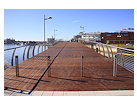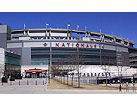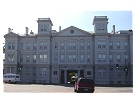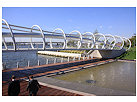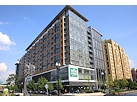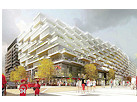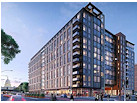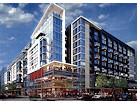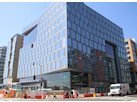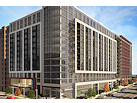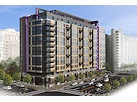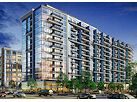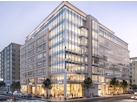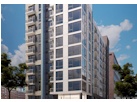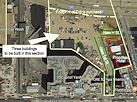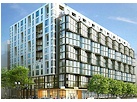|
| ||||||||||||||||||||
Please note that JDLand is no longer being updated.
peek >>
Near Southeast DC Past News Items: Sep 21, 2009
- Full Neighborhood Development MapThere's a lot more than just the projects listed here. See the complete map of completed, underway, and proposed projects all across the neighborhood.
- What's New This YearA quick look at what's arrived or been announced since the end of the 2018 baseball season.
- Food Options, Now and Coming SoonThere's now plenty of food options in the neighborhood. Click to see what's here, and what's coming.
- Anacostia RiverwalkA bridge between Teague and Yards Parks is part of the planned 20-mile Anacostia Riverwalk multi-use trail along the east and west banks of the Anacostia River.
- Virginia Ave. Tunnel ExpansionConstruction underway in 2015 to expand the 106-year-old tunnel to allow for a second track and double-height cars. Expected completion 2018.
- Rail and Bus Times
Get real time data for the Navy Yard subway, Circulator, Bikeshare, and bus lines, plus additional transit information. - Rail and Bus Times
Get real time data for the Navy Yard subway, Circulator, Bikeshare, and bus lines, plus additional transit information. - Canal ParkThree-block park on the site of the old Washington Canal. Construction begun in spring 2011, opened Nov. 16, 2012.
- Nationals Park21-acre site, 41,000-seat ballpark, construction begun May 2006, Opening Day March 30, 2008.
- Washington Navy YardHeadquarters of the Naval District Washington, established in 1799.
- Yards Park5.5-acre park on the banks of the Anacostia. First phase completed September 2010.
- Van Ness Elementary SchoolDC Public School, closed in 2006, but reopening in stages beginning in 2015.
- Agora/Whole Foods336-unit apartment building at 800 New Jersey Ave., SE. Construction begun June 2014, move-ins underway early 2018. Whole Foods expected to open in late 2018.
- New Douglass BridgeConstruction underway in early 2018 on the replacement for the current South Capitol Street Bridge. Completion expected in 2021.
- 1221 Van290-unit residential building with 26,000 sf retail. Underway late 2015, completed early 2018.

- NAB HQ/AvidianNew headquarters for National Association of Broadcasters, along with a 163-unit condo building. Construction underway early 2017.
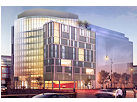
- Yards/Parcel O Residential ProjectsThe Bower, a 138-unit condo building by PN Hoffman, and The Guild, a 190-unit rental building by Forest City on the southeast corner of 4th and Tingey. Underway fall 2016, delivery 2018.
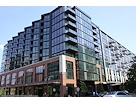
- New DC Water HQA wrap-around six-story addition to the existing O Street Pumping Station. Construction underway in 2016, with completion in 2018.
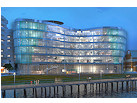
- The Harlow/Square 769N AptsMixed-income rental building with 176 units, including 36 public housing units. Underway early 2017, delivery 2019.

- West Half Residential420-unit project with 65,000 sf retail. Construction underway spring 2017.
- Novel South Capitol/2 I St.530ish-unit apartment building in two phases, on old McDonald's site. Construction underway early 2017, completed summer 2019.
- 1250 Half/Envy310 rental units at 1250, 123 condos at Envy, 60,000 square feet of retail. Underway spring 2017.
- Parc Riverside Phase II314ish-unit residential building at 1010 Half St., SE, by Toll Bros. Construction underway summer 2017.
- 99 M StreetA 224,000-square-foot office building by Skanska for the corner of 1st and M. Underway fall 2015, substantially complete summer 2018. Circa and an unnamed sibling restaurant announced tenants.
- The Garrett375-unit rental building at 2nd and I with 13,000 sq ft retail. Construction underway late fall 2017.
- Yards/The Estate Apts. and Thompson Hotel270-unit rental building and 227-room Thompson Hotel, with 20,000 sq ft retail total. Construction underway fall 2017.
- Meridian on First275-unit residential building, by Paradigm. Construction underway early 2018.
- The Maren/71 Potomac264-unit residential building with 12,500 sq ft retail, underway spring 2018. Phase 2 of RiverFront on the Anacostia development.
- DC Crossing/Square 696Block bought in 2016 by Tishman Speyer, with plans for 800 apartment units and 44,000 square feet of retail in two phases. Digging underway April 2018.
- One Hill South Phase 2300ish-unit unnamed sibling building at South Capitol and I. Work underway summer 2018.
- New DDOT HQ/250 MNew headquarters for the District Department of Transportation. Underway early 2019.
- 37 L Street Condos11-story, 74-unit condo building west of Half St. Underway early 2019.
- CSX East Residential/Hotel225ish-unit AC Marriott and two residential buildings planned. Digging underway late summer 2019.
- 1000 South Capitol Residential224-unit apartment building by Lerner. Underway fall 2019.
- Capper Seniors 2.0Reconstruction of the 160-unit building for low-income seniors that was destroyed by fire in 2018.
- Chemonics HQNew 285,000-sq-ft office building with 14,000 sq ft of retail. Expected delivery 2021.
2 Blog Posts
In a blissfully short 26-minute hearing, the city's Zoning Commission approved tonight the series of amendment requests to allow the Trapeze School New York to set up shop on Parcel O at the Yards, on the southeast corner of Fourth and Tingey.
The commissioners seemed satisfied with the information they had in the Office of Planning report and the submissions from Forest City and the Trapeze School, and asked few questions (Chairman Hood was clearly trying to move things along). This is a temporary approval, allowing the Trapeze School to be at the Yards for five years, or longer if a Special Exception is later granted. The text amendments also waved the on-site parking requirement for the school, with new commissioner Konrad Schlater saying he was "comfortable" with it because parking "is definitely overbuilt" in the area around the ballpark. ANC 6D had voted 7-0 in support of the case as well. It's now expected that the National Capital Planning Commission will address the Trapeze School at its Oct. 1 meeting.
No date for the opening of the school in its new home was mentioned, though it was explained that Forest City was trying to expedite the process since the school is having to vacate its home at the old convention center site. There will still be building permits to be filed for and approved before the tent can be lifted.
Toward the end of the hearing, Ramsey Meiser of Forest City gave a bit of an update on the other projects in the first phase of the Yards. Here's the latest:
* They are continuing to work with the city's Housing Finance Agency to get the money together to (re)start on the Foundry Lofts, with a hoped-for completion date of late 2010 or early 2011.
* The Boilermaker Shop could open in 2011; this dovetails with what a commenter in this thread reported hearing over the weekend, although earlier today Forest City would not officially confirm for me any scheduled start date for the project, only that some retail tenants have been signed, but that Forest City can't name them publicly just yet. (Maybe in October.)
* The first retail in the Park at the Yards (in the old Lumber Shed building) could open in 2012; the park itself is expected to open next summer.
* "Parcel D", on the southeast corner of Fourth and M, is the site of the expected Harris Teeter (though Meiser didn't name them, saying only "a grocery store," since neither Forest City nor Harris Teeter have confirmed this rumor yet), and is now apparently going to be a residential building instead of office, which had been hinted at recently. It's expected delivery date is currently 2013.
* The Factory 202 lofts building at Fifth and M is not expected before 2014.
And all that's just the first phase! Meiser also said that Parcel N, the site of a surface parking lot on the southwest corner of Fourth and Tingey, would probably be the first project of Phase 2. But no date on that yet.
If you want to watch the hearing, visit DCOZ's On Demand Video page.
 Considering what it portended for the forgotten little patch of land I had been blogging about for the previous 20 months, this post of mine late in the evening on Sept. 21, 2004 was pretty understated: "Baseball coming to Near Southeast? 'District officials disclosed plans yesterday to build a publicly financed stadium costing more than $400 million on the Anacostia waterfront near South Capitol Street, amid growing signs that Major League Baseball will attempt to move the Montreal Expos to Washington.' It doesn't mean that baseball in DC is a done deal, or that the Near Southeast site is a done deal, but it's a very interesting decision, and one that would have a huge impact on Near Southeast if it were to happen."
Considering what it portended for the forgotten little patch of land I had been blogging about for the previous 20 months, this post of mine late in the evening on Sept. 21, 2004 was pretty understated: "Baseball coming to Near Southeast? 'District officials disclosed plans yesterday to build a publicly financed stadium costing more than $400 million on the Anacostia waterfront near South Capitol Street, amid growing signs that Major League Baseball will attempt to move the Montreal Expos to Washington.' It doesn't mean that baseball in DC is a done deal, or that the Near Southeast site is a done deal, but it's a very interesting decision, and one that would have a huge impact on Near Southeast if it were to happen." Yeah, kind of!
 Late the next day, I went out and took a set of photos throughout the 21 acres that would eventually become home to Nationals Park, knowing it was important to get a bunch of "before" photos should this stadium actually come to pass. This was in the days when my photo-taking was pretty much limited to firing my little point-and-shoot digital camera from behind the wheel while I drove around the neighborhood, having not quite yet worked up the bravery to get out on foot. (Eventually I documented all of the buildings that were demolished to make way for the ballpark, but this Sept. 22 excursion marks for me official start of what would become an all-consuming project for me over the next four years.)
Late the next day, I went out and took a set of photos throughout the 21 acres that would eventually become home to Nationals Park, knowing it was important to get a bunch of "before" photos should this stadium actually come to pass. This was in the days when my photo-taking was pretty much limited to firing my little point-and-shoot digital camera from behind the wheel while I drove around the neighborhood, having not quite yet worked up the bravery to get out on foot. (Eventually I documented all of the buildings that were demolished to make way for the ballpark, but this Sept. 22 excursion marks for me official start of what would become an all-consuming project for me over the next four years.)It wasn't until the next week that it was all made official, that the Expos were coming to town and that the city would pursue building a new stadium in Near Southeast. And the reality of the ballpark didn't truly come to pass until that marathon city council session in February 2006 that first voted down then finally ratified the stadium lease agreement (signed by MLB the next month), followed two days later by the court ruling allowing the eminent domain seizure of the land for the ballpark to move forward. Demolitions began in May 2006, and the construction was completed on time for the official opener on March 30, 2008.
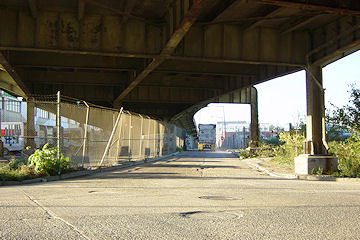 To look at not only the Sept. 22 ballpark-area photos but also a batch I took mainly around the Cappers footprint a few days earlier is to be reminded yet again of how much change has come to this area in the same amount of time that many people, say, pay off a new car. It's almost jarring to catch glimpses in these shots of the old South Capitol Street viaduct (demolished in July 2007) that in many ways was such a symbol of the old Near Southeast--how it walled the neighborhood off from Southwest, and how it helped perpetuate the area's overgrown industrial feeling, while allowing commuters to blow past it all without really having to look at it.
To look at not only the Sept. 22 ballpark-area photos but also a batch I took mainly around the Cappers footprint a few days earlier is to be reminded yet again of how much change has come to this area in the same amount of time that many people, say, pay off a new car. It's almost jarring to catch glimpses in these shots of the old South Capitol Street viaduct (demolished in July 2007) that in many ways was such a symbol of the old Near Southeast--how it walled the neighborhood off from Southwest, and how it helped perpetuate the area's overgrown industrial feeling, while allowing commuters to blow past it all without really having to look at it.It's going to be a while before big-time development resumes in the area (just like everywhere else in the city/region/country), but that doesn't make the changes that have already happened to this formerly forgotten little spot a mile south of the U.S. Capitol any less striking to look at.
|
Comments (0)
|



